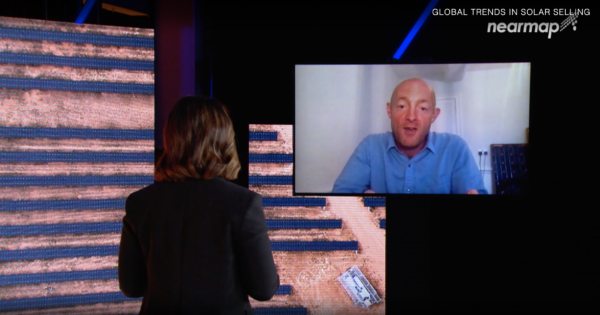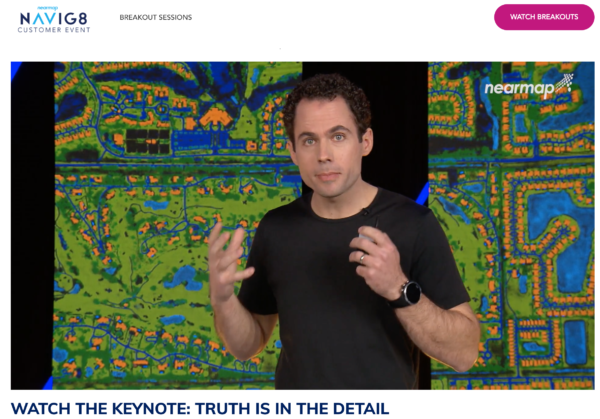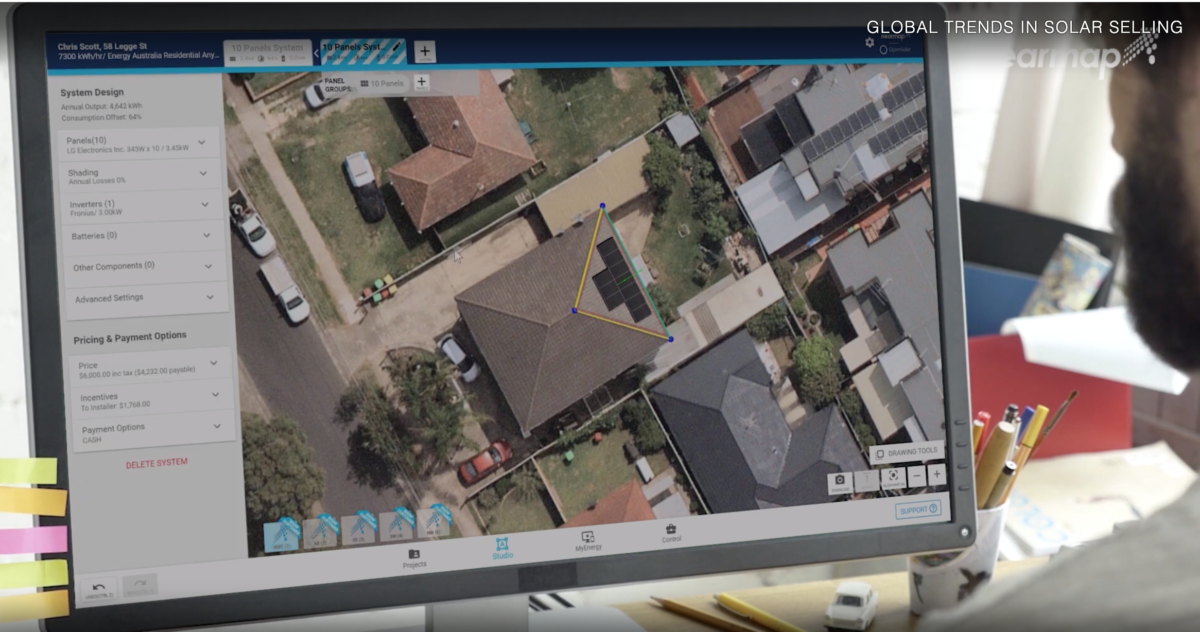From pv magazine Australia.
Nearmap presents the suburbs as a mosaic of solar panelled roofs, beside bare residential and commercial rooftop potential, swimming pools just soaking up energy and canopies of trees leaning in. A darling of the Australian Stock Exchange, the tech company’s regularly updated digitised aerial mapping — using vertical, oblique, 3D and AI enhanced imagery — of populated areas in Australia and the US, could prove the greatest boon to rooftop PV solar sellers in the time of COVID-19 and beyond. At Nearmap’s virtual Navig8 2020 event last week, it showcased its latest capabilities and partnerships.
Nearmap CEO Dr Rob Newman directly addressed solar designers, an important sector of the company’s customer base, saying that the company’s digitally delivered, high-res imagery of the lay of the solar landscape, will “profoundly change the way you work”.
He expanded: “By reducing site visits, we’re taking cars off the road. It’s reduced the risk; no longer do you need to climb up on a ladder to measure the geometry of a roof,” and, he added, that Nearmap’s content ultimately helps save installers valuable time in designing new rooftop systems.
“COVID has been a terrible struggle for small businesses and for the economy at so many levels,” said Andrew Birch (Birchy), co-founder of the OpenSolar platform and app, which was conceived to boost the efficiency of solar installers globally and thereby accelerate uptake of rooftop PV and arrest global warming.
OpenSolar has partnered with Nearmap since December 2019, incorporating access to Nearmap imagery in its purpose-built digital toolkit, which streamlines the design-and-quote process for installers by generating professional quotes, incorporating Nearmap imaging of homeowner’s roofs as they will appear with solar installed.

Coming soon: immersive 3D online quotes for PV
Speaking at Navig8 via livestream video from his home in the UK, Birchy said he was excited about the next iteration of Nearmap in the OpenSolar app, which will create a 3D immersive experience that allows solar installers to view a digital surface map of a property and its surroundings. They will be able to automatically calculate roof pitch using the orientation of the roof and its dimensions and use “ray tracing” of the sun as it moves across the roof and is filtered through nearby trees to accurately estimate what solar output will be.
A SolarTouch feature will allow installers to “paint” panels onto the roofs exactly as they will appear on the prospective customer’s roof.
Birchy said, “really accurate” vertical imagery (captured from directly above) is already helping subscribers to the Nearmap function on the otherwise free OpenSolar app, get individual system designs right first time, without physically visiting the property, thereby providing a financial benefit and the safety of social distancing in these pandemic times.
From the customer perspective, he noted, accurate, high-quality imagery creates trust in the solution. “The home is usually the biggest asset a family has, so how those panels appear on the roof is important to them,” Birchy said.
“A poorly laid out presentation with grainy imagery, or no imagery at all, is hard to understand, and you wonder, ‘What am I buying?’” he asserted. In contrast, a well formatted, installer-branded proposal, with beautiful images of the property with virtual panels in place, and clear calculations of how much the system will save them in electricity bills and carbon emissions, “is much more compelling” in helping customers to “see the real value proposition in solar”.
Making the pandemic work for emissions reduction
Online consumer purchasing has been accelerated by pandemic conditions of lockdown, and Birchy sees the desire to become self-sufficient in essentials, whether that’s toilet paper or home-generated energy and battery storage, as a potential boost to the uptake of rooftop PV.
“You know, globally, we’re still only at about 1% to 2% penetration,” said this solar evangelist, who pioneered the integration of solar system design, sales and financing at Sungevity, the wildly successful company he launched with then business partner Adam Pryor in California 12 years ago.
Although he acknowledges Australia’s world-leading 20% residential solar penetration, he says the scope to lower emissions by driving a revolution in worldwide residential solar uptake represents a huge opportunity that is significantly hampered by the time it takes any installer to make a sale by traditional methods. He’s passionate about giving installers the digital tools they need to speed up global domination of rooftop PV.
Layer upon intelligent layer
The Nearmap team is similarly passionate about using its world-leading aerial image-capture and image-processing technologies to revolutionise how businesses and government agencies use visual data to catalogue, analyse and manage assets, pursue opportunities and help ensure the safety of populations.
At Navig8 2020, which was themed “Truth is in the detail”, Newman said he had been in discussions with the Australian Department of Education last year: “They were trying to determine where to put new primary schools” by “driving the streets and counting construction of new houses”. Nearmap imagery, enabled by algorithms that seek and accurately identify construction sites, is likely to find application here.
Another Nearmap overlay clearly highlights all homes with swimming pools and therefore high energy needs; conflate that with data on large, well-oriented rooftops, and the opportunity for solar installation knocks.
Nearmap currently has regularly updated digital imagery of 89% of Australia’s populated areas, and 71% in the US.
The company says installers can “prospect an entire region for solar leads in a few hours”. Comparing historical imagery with current maps for insights into trends and growth patterns can also help pinpoint the most likely candidates for conversion to low-cost rooftop generation.
Dr Mike Bewley, senior director of AI Systems for Nearmap, said at Navig8: “As time goes on, the model continues to learn and improve.” For example, Nearmap AI can now in most cases accurately distinguish between solar PV and solar hot water — “that’s something most humans struggle to do without expert training”.

Accelerating transition at rooftop and grid levels
Such detail may also help electricity retailers and network service providers identify the location of residential and commercial solar assets in the grid, ahead of and supplementary to the Australian Energy Market Operator’s evolving Distributed Energy Resources Register. This information has been hard to accumulate, but is critical to the management of distributed resources for stability of the transitioning energy system, and to decide where storage assets should be deployed to support the grid.
Birchy is bent on changing the rooftop landscape so that future Nearmap data shows a blanket of solar across the mapped residential universe.
At Navig8 2020, he emphasised the urgency of increasing the efficiencies of the solar sales process, “so that we can scale faster, because obviously the bigger challenge behind COVID is climate change, and solar as a low-cost solution is really our best hope of addressing that problem”.
This content is protected by copyright and may not be reused. If you want to cooperate with us and would like to reuse some of our content, please contact: editors@pv-magazine.com.




0 comments
By submitting this form you agree to pv magazine using your data for the purposes of publishing your comment.
Your personal data will only be disclosed or otherwise transmitted to third parties for the purposes of spam filtering or if this is necessary for technical maintenance of the website. Any other transfer to third parties will not take place unless this is justified on the basis of applicable data protection regulations or if pv magazine is legally obliged to do so.
You may revoke this consent at any time with effect for the future, in which case your personal data will be deleted immediately. Otherwise, your data will be deleted if pv magazine has processed your request or the purpose of data storage is fulfilled.
Further information on data privacy can be found in our Data Protection Policy.